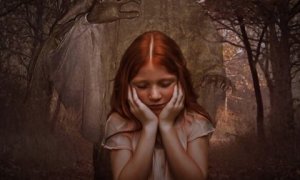The Most Common Fears in Children


Written and verified by the psychologist Raquel Aldana
There are many studies on the most common fears in children. But are there differences between genders? The truth is that, both in childhood and adolescence, being afraid is associated to a greater extent with females.
Nonetheless, this stereotype may have a cultural explanation as it’s strictly forbidden for males to show and recognize that they’re afraid of something in some cultures. Another point is how society may not reflect too frequently on the difference between the content of fears if we look at how these differ between boys and girls. Let’s look at this more closely.
The Most Common Fears in Children According to Their Gender

According to Valiente, Sandín, Chorot, and Tabar (2003), girls tend to show more fear of darkness, strange places, sounds, strange objects or people, being kidnapped, robbed or killed, snakes, dirt, and animals.
In contrast, boys show greater fear of danger, physical harm, school, failure, nightmares, and imaginary beings. Note also that, as a general rule, girls score higher in the different categories. That is, establishing a wider difference in fears such as those related to rats, spiders, snakes, mice, mysterious-looking houses, and/or loneliness.
However, it should be noted that these differences occur when fear is evolutionary. Because there’s no difference between boys and girls when we talk about fears that reach a clinical level. Besides, the trend sort of decreases at the age of 9 to 11 in girls, which doesn’t occur so sharply in boys.
“We can easily forgive a child who’s afraid of the dark; the real tragedy of life is when men are afraid of the light.”
-Plato-
The Most Common Fears in Children Are Evolutionary

Fears in children are among the most common reasons for consultation in pediatric clinics. What very few people know is that many of these fears are normal, evolutionary, and will disappear over time. Nevertheless, keep in mind that fears shouldn’t be a concern as long as they aren’t too intense. That is, as long as it doesn’t limit the child’s ability to lead a normal life for an extended period of time.
The fact that this is unknown often leads to ineffective strategies that, far from relieving fear, promote and make them worse. Therefore, it’s important to be aware that fears in children and teenagers are evolutionary and that they merely respond to phylogenetic reasons.
This means that the fact that a young child is afraid when they’re not with their parents is an adaptive fear. Because human evolution determined at some point that it’s not a good idea to separate from one’s primary caregivers. Young children just know that there may be dangers out there that they aren’t yet capable to confront on their own.

Obviously, life nowadays is quite different and many of the fears still present in children no longer make sense. They’re neither easy to explain nor relevant to this time and day. However, you should still know what fears are normal in each evolutionary stage so you can help your children cope with them.
Fears in Children Also Vary by Age
- First of all, during a child’s first year of life, the most common fears are related to the loss of support. Also, to loud sounds, heights, and strange people or objects. In addition, they truly fear separation from their reference figures or threatening objects that appear suddenly. Thus, fear of strangers may continue as shyness as children get older. It can also worsen due to their separation anxiety.
- From the age of one to two and a half, the most common fears are separating from their parents or reference figures, strangers, storms, small animals, and insects. It’s important to note that the fear of separation intensifies after a child turns two.
- The pre-school stage (two and a half to six years of age). The most common fears during this stage are related to darkness and animals in general. Also, they fear to be alone as they think ghosts and monsters exist. Their fears of imaginary beings and wild animals get stronger.
- From age six to 11, the most persistent fears are of supernatural events, bodily injuries and physical damage, health, death, and school (academic performance, peers, social relationships, etc.).
- After the age of 11, most fears begin to stagnate or stabilize. However, some fears tend to skyrocket, such as those related to various medical conditions. For example, the fear of going to the doctor or getting an injection. Other fears that increase in this stage are related to social stress (public speaking, not having friends, losing friends, failure, criticism, etc.), as well as fears related to danger or death.
Conclusion
As you can see, fear is an emotion that remains with us throughout our lives in one way or another. Depending on how it’s managed and its particular characteristics, fears in children may or may not disappear. At the end of adolescence and at the beginning of adulthood, the fears that remain become a lot stronger. For this reason, parents should help their children develop their natural cycle properly early on.
There are many studies on the most common fears in children. But are there differences between genders? The truth is that, both in childhood and adolescence, being afraid is associated to a greater extent with females.
Nonetheless, this stereotype may have a cultural explanation as it’s strictly forbidden for males to show and recognize that they’re afraid of something in some cultures. Another point is how society may not reflect too frequently on the difference between the content of fears if we look at how these differ between boys and girls. Let’s look at this more closely.
The Most Common Fears in Children According to Their Gender

According to Valiente, Sandín, Chorot, and Tabar (2003), girls tend to show more fear of darkness, strange places, sounds, strange objects or people, being kidnapped, robbed or killed, snakes, dirt, and animals.
In contrast, boys show greater fear of danger, physical harm, school, failure, nightmares, and imaginary beings. Note also that, as a general rule, girls score higher in the different categories. That is, establishing a wider difference in fears such as those related to rats, spiders, snakes, mice, mysterious-looking houses, and/or loneliness.
However, it should be noted that these differences occur when fear is evolutionary. Because there’s no difference between boys and girls when we talk about fears that reach a clinical level. Besides, the trend sort of decreases at the age of 9 to 11 in girls, which doesn’t occur so sharply in boys.
“We can easily forgive a child who’s afraid of the dark; the real tragedy of life is when men are afraid of the light.”
-Plato-
The Most Common Fears in Children Are Evolutionary

Fears in children are among the most common reasons for consultation in pediatric clinics. What very few people know is that many of these fears are normal, evolutionary, and will disappear over time. Nevertheless, keep in mind that fears shouldn’t be a concern as long as they aren’t too intense. That is, as long as it doesn’t limit the child’s ability to lead a normal life for an extended period of time.
The fact that this is unknown often leads to ineffective strategies that, far from relieving fear, promote and make them worse. Therefore, it’s important to be aware that fears in children and teenagers are evolutionary and that they merely respond to phylogenetic reasons.
This means that the fact that a young child is afraid when they’re not with their parents is an adaptive fear. Because human evolution determined at some point that it’s not a good idea to separate from one’s primary caregivers. Young children just know that there may be dangers out there that they aren’t yet capable to confront on their own.

Obviously, life nowadays is quite different and many of the fears still present in children no longer make sense. They’re neither easy to explain nor relevant to this time and day. However, you should still know what fears are normal in each evolutionary stage so you can help your children cope with them.
Fears in Children Also Vary by Age
- First of all, during a child’s first year of life, the most common fears are related to the loss of support. Also, to loud sounds, heights, and strange people or objects. In addition, they truly fear separation from their reference figures or threatening objects that appear suddenly. Thus, fear of strangers may continue as shyness as children get older. It can also worsen due to their separation anxiety.
- From the age of one to two and a half, the most common fears are separating from their parents or reference figures, strangers, storms, small animals, and insects. It’s important to note that the fear of separation intensifies after a child turns two.
- The pre-school stage (two and a half to six years of age). The most common fears during this stage are related to darkness and animals in general. Also, they fear to be alone as they think ghosts and monsters exist. Their fears of imaginary beings and wild animals get stronger.
- From age six to 11, the most persistent fears are of supernatural events, bodily injuries and physical damage, health, death, and school (academic performance, peers, social relationships, etc.).
- After the age of 11, most fears begin to stagnate or stabilize. However, some fears tend to skyrocket, such as those related to various medical conditions. For example, the fear of going to the doctor or getting an injection. Other fears that increase in this stage are related to social stress (public speaking, not having friends, losing friends, failure, criticism, etc.), as well as fears related to danger or death.
Conclusion
As you can see, fear is an emotion that remains with us throughout our lives in one way or another. Depending on how it’s managed and its particular characteristics, fears in children may or may not disappear. At the end of adolescence and at the beginning of adulthood, the fears that remain become a lot stronger. For this reason, parents should help their children develop their natural cycle properly early on.
All cited sources were thoroughly reviewed by our team to ensure their quality, reliability, currency, and validity. The bibliography of this article was considered reliable and of academic or scientific accuracy.
Valiente, R., Sandín, B. & Chorot, P. (2003). Miedos en la infancia y en la adolescencia. Librería UNED, Madrid.
This text is provided for informational purposes only and does not replace consultation with a professional. If in doubt, consult your specialist.







